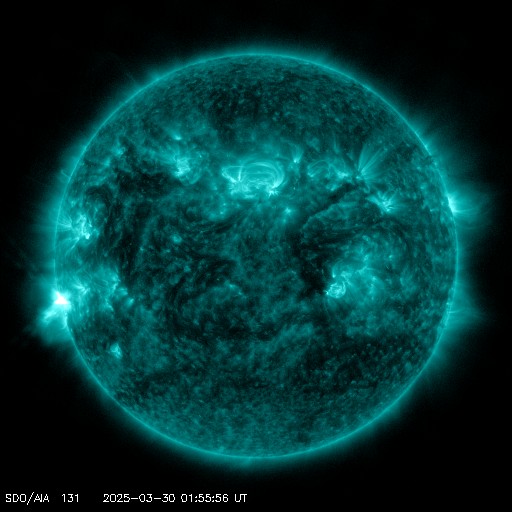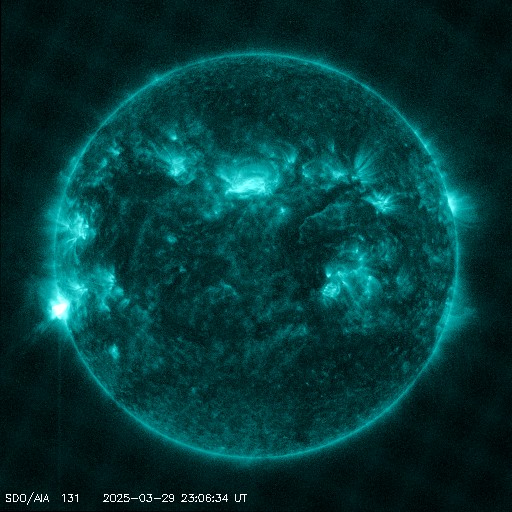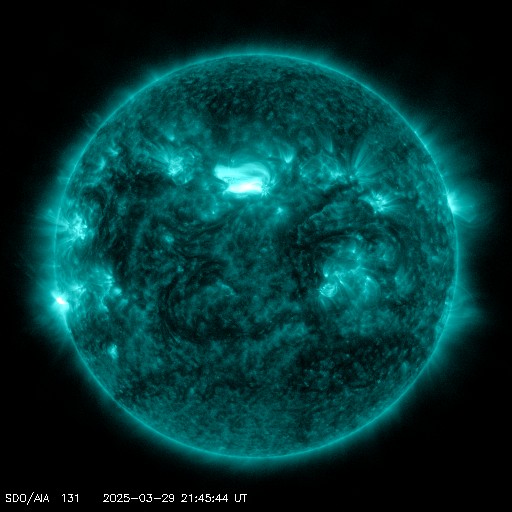Viewing archive of Tuesday, 24 April 2012
Solar activity report
Any mentioned solar flare in this report has a scaling factor applied by the Space Weather Prediction Center (SWPC). Because of the SWPC scaling factor, solar flares are reported as 42% smaller than for the science quality data. The scaling factor has been removed from our archived solar flare data to reflect the true physical units.
Report of Solar-Geophysical Activity 2012 Apr 24 2200 UTCPrepared by the NOAA © SWPC and processed by SpaceWeatherLive.com
Joint USAF/NOAA Report of Solar and Geophysical Activity
SDF Number 115 Issued at 2200Z on 24 Apr 2012IA. Analysis of Solar Active Regions and Activity from 23-2100Z to 24-2100Z
Solar activity has been at low levels for the past 24
hours with multiple C-class x-ray events. A C3 flare was observed at
24/0745Z off the east limb from new Region 1467 (N14E72). Associated
with this event, were both a type II radio sweep (estimated shock
velocity of 1029 km/s) and a non-Earth directed CME. Two other new
regions were numbered today, Region 1468 (N09E12) which rapidly
emerged on the disk and Region 1469 (S21E68), which rotated onto the
disk. The remaining active regions were stable and quiet today,
except for Region 1465 (S19W12). Region 1465 showed a consolidation
of both leader and follower spot groups into one cluster and is now
classified as a beta-gamma-delta.
IB. Solar Activity Forecast
Solar activity is expected to be at
low levels with a slight chance for M-class activity for the next
three days (25 - 27 April).
IIA. Geophysical Activity Summary 23-2100Z to 24-2100Z
The geomagnetic field ranged from quiet to major storm levels during
the past 24 hours due to continued CME effects and the arrival of a
coronal hole high speed stream (CH HSS). Early in the period,
measurements from the ACE spacecraft showed extensive southward
(negative) periods of the Bz component of the IMF. Even though solar
wind speeds remained well below nominal levels, these periods drove
the majority of the geomagnetic activity. Around 24/0200Z, CH HSS
characteristics were observed by the ACE spacecraft with solar wind
density dropping off as the solar wind speed increased. At the time
of this report, solar wind speeds had increased from around 350 km/s
to around 630 km/s.
IIB. Geophysical Activity Forecast
The geomagnetic field is
expected to be at quiet to active levels on day one (25 April) as
the effects of a CH HSS continue. An increase to active with a
chance for isolated minor storm periods is expected on day two (26
April) as the CME from 23 April is expected to become geoeffective.
Quiet to unsettled levels are expected on day three (27 April) as
effects of the CME wane.
III. Event Probabilities 25 Apr to 27 Apr
| Class M | 20% | 20% | 20% |
| Class X | 01% | 01% | 01% |
| Proton | 01% | 01% | 01% |
| PCAF | green | ||
IV. Penticton 10.7 cm Flux
Observed 24 Apr 134 Predicted 25 Apr-27 Apr 130/130/125 90 Day Mean 24 Apr 112
V. Geomagnetic A Indices
Observed Afr/Ap 23 Apr 021/030 Estimated Afr/Ap 24 Apr 021/031 Predicted Afr/Ap 25 Apr-27 Apr 012/018-017/022-011/015
VI. Geomagnetic Activity Probabilities 25 Apr to 27 Apr
| A. Middle Latitudes | |||
|---|---|---|---|
| Active | 25% | 40% | 25% |
| Minor storm | 10% | 20% | 10% |
| Major-severe storm | 01% | 05% | 01% |
| B. High Latitudes | |||
|---|---|---|---|
| Active | 45% | 50% | 40% |
| Minor storm | 25% | 30% | 25% |
| Major-severe storm | 15% | 15% | 10% |
All times in UTC
Current data suggests there is a slight possibility for aurora to appear at the following high latitude regions in the near future
Gillam, MB, Yellowknife, NTLatest news
Latest forum messages
AR4048 20AR4043 47AR4046 128Incoming & Unnumbered Active Regions 1658Aurora photography hints for those of us with smartphones 51
More topicsSupport SpaceWeatherLive.com!
A lot of people come to SpaceWeatherLive to follow the Sun's activity or if there is aurora to be seen, but with more traffic comes higher server costs. Consider a donation if you enjoy SpaceWeatherLive so we can keep the website online!

Latest alerts
02:09 UTC - Solar flare
Moderate M1.54 flare from sunspot region 4048
01:42 UTC - Radio Blackout
Minor R1 radio blackout in progress (≥M1 - current: M1.24)
Saturday, 29 March 2025
23:21 UTC - Solar flare
Moderate M1.91 flare from sunspot region 4048
22:51 UTC - Radio Blackout
Minor R1 radio blackout in progress (≥M1 - current: M1.1)
21:57 UTC - Solar flare
Moderate M1.45 flare from sunspot region 4048
Space weather facts
| Last X-flare | 2025/03/28 | X1.1 |
| Last M-flare | 2025/03/30 | M1.5 |
| Last geomagnetic storm | 2025/03/27 | Kp5 (G1) |
| Spotless days | |
|---|---|
| Last spotless day | 2022/06/08 |
| Monthly mean Sunspot Number | |
|---|---|
| February 2025 | 154.6 +17.6 |
| March 2025 | 127.5 -27.1 |
| Last 30 days | 127.5 -24.7 |





